Contents
- 1. Pronunciation of mantra and its importance
- 2. Benefits of chanting mantra
- 3. Practical suggestions
- 4. Why is it said that ‘A mantra should be kept a secret?’
- 5. Comparison with other paths of Yoga
1. Mantra Pronunciation and its importance
‘The objective behind doing spiritual practice of mantras is to reveal their obscure energy. Sages have already described what benefits a particular mantra yields. A mantra is not merely a union of letters. Their combination is a representation of inner energy. The energy within a seeker gets activated due to a mantra and he acquires tremendous strength. The divine consciousness (chaitanya) in a mantra is superior to the gross words in it. It is found that if one performs the purashcharan (chanting) of a mantra infallibly and with assertion then one can experience the powerful energy in it and can achieve anything from mundane detachment of greed to Self-realisation.
The science of Mantra has originated from the word (shabda) Brahman. The energy of a mantra lies in its pronunciation. That energy is manifested from frequencies generated in the atmosphere by the sound vibrations that are generated through its chanting. The nature of the mantra is one of radiance (tej). Though it appears rather meaningless it is laden with the potential to bring about the manifestation of a deity.
The power of a mantra itself is the power of the mind which in turn is the power of one’s thoughts. Thoughts which are devoid of words are very subtle. When thoughts are expressed in words, they become gross. It is evident that the energy in the gross is less than that in the subtle. The energy in a mantra in the form of thought or meaning is always greater than mantra pronunciation in the form of words. Considering the tremendous power generated by thought, Indian philosophers proclaimed the shocking doctrine over five thousand years ago that bad thoughts are more harmful than bad words.’ (1)
Once one concentrates on mantra pronunciation correctly, the mind does not wander and this helps build up concentration of the mind.
Sound (nad) is the basic component of creation and is based on the sciences of Music and Mantra. Now pronounce Om as one usually does and note the spiritual experience. Then prolong the duration of Om three to four times, that is O….m…. and then record the experience. With the prolonged Om one experiences more energy or goes into a kind of trance, than with the usual Om. The reason for this is that with the usual pronunciation only one direction is stimulated whereas with the prolonged variation all the eight directions are stimulated. It is for this very reason that usually when a note is prolonged a positive effect is obtained.
In the Vedas too, the mere meaning is unimportant. One should be able to recite them with the correct rhythm (chanda), syllabic foot (vrutta) and measure of verse (matra). Only then is the real benefit obtained. With such Vedic chanting one also acquires the benefit of pranayam.
‘A mantra should be obtained only from the Guru and should be chanted according to the science of Matras. A matra is that with which one realises the magnitude of the sound of words. The science of Matras, that is the correct pronunciation of the mantras as regards their notes such as aroha, avaroha, udatta, anudatta, svarit, prachay, etc. is of special importance. If there is an error in that then the deleterious effects that can be caused are described with examples in the teachings of Panini as –
मन्त्रो हीन: स्वरतो वर्णतो वा मिथ्याप्रयुक्तो न तमर्थमाह ।
स वाग्वज्रो यजमानं हिनस्ति यथेन्द्रशत्रु: स्वरतोऽपराधात् ।The meaning: The mantra without proper pronunciation of vowels (svar) and consonants (varna), that is the utterance of a mantra in a faulty manner makes it faulty and does not convey the intended meaning. Instead it gets converted into a verbal thunderbolt and harms the one chanting it, as had occurred in the case of the word Indrashatru with faulty pronunciation of the vowels.
The compound word Indrashatru could have two meanings, one being “Indra’s enemy” (the slayer of Lord Indra) from Tatpurush Samas and “the one whose enemy is Lord Indra” (the one who will be slain by Lord Indra) from Bahuvrihi Samas. Since the first meaning was intended for Tvashta he had to utter the note of the last letter of the entire word in a lofty tone. He however, uttered the last letter of the first word in the Samas in a lofty tone. Consequently, instead of a son being born to slay Lord Indra, a son, Vrutra who would be killed by Lord Indra was born. (Taittiriya Sanhita 2.5.1-2)
The teachings of Panini further say,
अनक्षरं हतायुष्यं विस्वरं व्याधिपीडितम् ।
अक्षता शस्त्ररूपेण वज्रं पतति मस्तके ।।The meaning: If some of the consonants in a mantra are deleted then they destroy life, if the vowels (svar) are faulty then disease sets in. The consecrated rice (akshata) [consecrated with a mantra which has discordant vowels and omission of letters] descends upon the head of the host like a thunderbolt (vajra).
Only a mantra imparted by an appeased Guru, one obtained in a dream or from a deity during meditation or accepted after the performance of appropriate rites such as the removal of kilak, chanted with pure and appropriate notes observing the ritualistic rules and restrictions can prove successful and even endorse the desired benefits. Chanting a mantra read in a book and getting initiation of a mantra from a person without spiritual authority is not only meaningless but also disastrous.’ (2)
‘One comes across Narad and Tumbaru as a pair in the Purans. Tumbaru possessed knowledge of music but Narad did not and hence was once insulted by Lakshmi, the deity of wealth. Then Narad began to learn music from Tumbaru. Once as He was singing, all the Raginis, the deities of musical notes appeared before Him. They were emaciated and drained of energy. When Narad asked them the reason for their state they replied, “We have been reduced to this state because of your improper and harsh singing. Now, after hearing Tumbaru sing we will return to our original state.” Narad was humiliated hearing this. He then proceeded to Shvetadipa and prayed to Lord Vishnu asking for the knowledge of music. Lord Vishnu responded, “I will teach you music in My incarnation as Krushna.” Later along with His wives Rukmini, Satyabhama and Jambavati Krushna Himself perfected Him with the knowledge of singing.’ (3)
Our ears are influenced by sound (nad). How one perceives the various characteristics of an object through the different sense organs is described in the following table. From this table one will also realise the superiority of the sense organ of hearing, over the others. Just as in us the sense organ of hearing is the most important so also of the five universal subtle sense organs, the subtle sense organ of hearing is the most important. It is activated by sound (nad).
| Akash (absolute ether) |
Vayu (absolute air) |
Tej (absolute fire) |
Apa (absolute water) |
Pruthvi (absolute earth) |
|
| 1. The sense organs | ears | skin | eyes | tongue | nose |
| 2. What can the sense organ perceive? |
word (sound) |
touch | form (figure) |
taste | odour |
| 3. Knowledge about a person or an object existing in the present |
yes | yes | yes | yes | yes |
| 4. Knowledge of an object without its entering one’s body |
yes | yes | yes | – | yes |
| 5. Knowledge of a person or an object from a distance |
yes | – | yes | – | – |
| 6. The ability to acquire knowledge about the past or future of a person or an object or information related to it or the gross emotions, as described or written by someone |
yes | – | yes | – | – |
| 7. Acquisition of knowledge of subtle frequencies generated from the motor organs of a person by the subtle sense organ |
yes* | – | – | – | – |
* Knowledge is acquired from the subtle sound generated from the movements of the motor organs.
1.1 Mantra Pronunciation and purification of speech
When any word is pronounced aloud or mentally according to the rules of grammar, purification of speech is achieved.
2. Benefits of chanting mantra and mantra pronunciation
- A. The deity of the mantra is appeased through veneration.
- B. Spiritual progress
- C. Protection: A mantra is a tremendous force. According to the science of Mantra, the armours (kavach) of different deities are – Lakshmi kavach, Shiva kavach, Gopal kavach, Viíhnu kavach, Datta kavach, Ramaraksha, Maruti stotra, etc. By regular recitation of these mantras an armour is created around the physical body. Evolved seekers can either see or sense this armour. These subtle armours are stronger than the gross ones. Gross armours protect against gross weapons such as bullets while the subtle ones protect against gross as well as subtle energies such as spirits, black magic (karni), etc.
Some mantra or yantra is written on a leaf, a sheet of paper or tin and is inserted into an amulet and then worn around the neck or tied on the arm. That is also called an armour. An armour is used either to protect the body, to combat disease or to fulfill some wish. Just as a deity has its verse of praise (stotra) it also has its own armour. This armour contains a prayer for protection of all the organs in one’s body. The ‘Rama kavach’ given below is a part of the famous ‘Ramaraksha’ verse.
शिरो मे राघव: पातु भालं दशरथात्मज: ।।
कौसल्येयो दृशौ पातु विश्वामित्रप्रिय: श्रृति: ।…The meaning: May Lord Raghav protect my head. May the son of Dasharath protect my forehead, may my eyes be protected by the son of Kousalya, the ears by the one dear to Sage Vishvamitra.
- D. Destruction of the enemy
- E. Acquisition of supernatural powers (siddhis): One can gain control over different elements including the akash (absolute ether) element with mantras. As a result various supernatural powers are acquired.
- F. Nullification of sins
- G. Purification of speech: Refer point ‘1.1’.
2.1 Preconditions
- A. ‘For the energy of a mantra to manifest itself one has to chant the mantra. Chanting means repetition in rounds (avartans). However, these rounds should also include the meaning of the mantra and not mere words. Hence, rather than mere utterance, chanting the mantra with spiritual emotion (bhav) after understanding its meaning, is implied in its chanting.
- B. The mantra should be chanted with faith.
मंत्रे तीर्थे देवे व्दिजे दैवज्ञे भेषजे गुरौ ।
यादृशी भावना यस्य सिद्घिर्भवति तादृशी ।।The meaning: One gets the benefit according to the amount of faith that one has in a mantra, holy water (tirtha), God, a Brahman, an astrologer, a physician and a Guru.
- C. The thoughts and behaviour should be sattvik (sattva predominant) in nature.
- D. The practice of Tantra is useful for a mantra. The practice of Tantra involves drawing figures (yantras) such as triangles, quadrangles, circles, etc. on paper or engraving them on copper sheets and worshipping them ritualistically.’ (4) Refer ‘Mantra Pronunciation and its importance’.
2.2 The signs of progress
- A. Disappearance of obstacles in spiritual practice.
- B. Visions of auspicious signs
- C. Spiritual experiences denoting spiritual progress
- D. The divine consciousness of a mantra (mantrachaitanya): The mantra, its meaning and the deity of the mantra blend into one.
The signs of progress from chanting, mentioned in ‘Science of Spirituality : Chapter 9 – Path of Chanting The Lord’s Name (Namasankirtanyoga)’ are applicable to chanting of mantras (mantrajapa) as well. The ultimate progress in this means the blending of the mantra, the act of chanting it and the one chanting it,that is dissolution of their triad. In other words, it is the realisation of non-duality (advait).
3. Practical suggestions
‘The Rudrayamal states that a man should not initiate his wife, his children or his brother with a mantra. The Yoginitantra mentions that one should not receive initiation of a mantra from one’s father, maternal grandfather, younger brother and anyone from the enemy’s camp. According to the Sarsangraha, in a good place of pilgrimage, during solar and lunar eclipses and on the full moon day of Shravan (Shravani pournima) of the Hindu lunar calendar one does not need to consider the auspiciousness of the day (tithi), stars, etc. for receiving an initiation. On other days however one has to find an auspicious moment (muhurt) for it.’ (5)
4. Why is it said that ‘A mantra should be kept a secret?’
- A. Since each one’s mantra is different one knowing the other’s mantra would not be of any use to the other.
- B. If one chants another’s mantra wrongly it may prove harmful to him.
- C. When initiating a seeker with a mantra, the Guru considers his requirements and incorporates His energy into it. When the same mantra is told by that seeker to someone else the latter does not benefit from it as the former does not have spiritual energy. If this happens, then there is a possibility that on hearing the latter’s experience the former may get misled and he too may give up spiritual practice.
- D. When one has to keep some secret one remembers it incessantly. Similarly when a mantra has to be kept a secret, the chanting of the mantra increases.
However, when conversing with other seekers there is no need to keep a mantra or any other spiritual practice a secret as through it everyone is able to learn something. Besides, discussion does not cause any harm. The Gurumantra we were initiated with is ‘Shrirama jai Rama jai jai Rama.’
5. Comparison with other paths of Yoga
5.1 Chanting The Lord’s Name (Namajapa) and chanting a mantra (mantrajapa)
Chanting (japa) is repetition of a letter, word, group of words or a sentence. The following table compares the chanting of The Lord’s Name and that of a mantra.
| Chanting The Lord’s Name |
Chanting a mantra (mantrajapa) |
|
| 1. Repetition | Present | Present |
| 2. Utterance of the intention (sankalpa) behind the chanting |
Absent | Present |
| 3. Rituals like sacrificial fires (hom, havan), etc. |
Not performed | Are performed |
| 4. A count of the chanting | Not to be maintained | Needs to be maintained as the chanting is based on quantity. No benefit is acquired if it is not counted. |
| 5. The minimum amount | – | A celibate (brahmachari) and a householder worshi- pping the ahitagni fire: 108, a retired householder (vanprasthi) and yati: 1000 |
| 6. The motive | Either with or without expectation (sakam nishkam) |
With expectation (sakam) to protect oneself, to destroy the enemy or to acquire supernatural powers (siddhis) or without expect- ations (nishkam) |
| 7. Initiation (diksha) from the Guru |
Mostly absent (some- times initiation of the Lord’s Name) |
Essential (initiation of a mantra) as the Guru also teaches the correct pronunciation. |
| 8. Ritualistic rules and restrictions |
Absent | Present. e.g. ritualistic rules are ‘bathing before comm- encing chanting of a mantra, eating fruit, drinking milk’, etc. during the specified quantity of chanting (anushthan) of the mantra. ‘Abstaining from eating meat’ is a restriction. |
| 9. The pronunciation | In any manner | Benefits are derived only if the pronunciation is correct. |
| 10. The time of practice | Anytime: there is no restriction of time |
At a particular time, e.g. the Gayatri mantra if chanted at sunrise and sunset proves more beneficial. |
| 11. The place of practice | Anywhere: even in the toilet |
Only in a pure place, e.g. a home, on the banks of a river, a cow shed, a place where fire is worshipped, a place of pilgrimage, in front of the idol of a deity of worship (upasyadevata) |
| 12. Possibility of harm | Never | It may prove harmful if the pronunciation is incorrect. |
5.2 Namasankirtanyoga, Dhyanyoga, Dnyanyoga and Mantrayoga
उत्तमा सहजावस्था मध्यमा ध्यानधारणा ।
अधमं तत्त्वचिंतनं मंत्रचिंताऽधमाधम: ।।As spiritual practice the natural state of being in communion with The Lord (sahajavastha) achieved through continuous chanting of The Lord’s Name is the best. Concentration (dharana) and meditation (dhyan) are next to it followed by mere contemplation on various principles from the path of Knowledge (Dnyanyoga) which is inferior. The spiritual practice of chanting a mantra however is inferior to them all.
Reference:
‘Path of Chanting The Lord’s Name (Namasankirtanyoga) and Path of Mantra (Mantrayoga)’, published by Sanatan Sanstha.
Bharatiya Sanskrutikosh. Publishers: Pandit Mahadevshastri Joshi, Secretary, Bharatiya Sanskrutikosh Mandal, 410 Shanivar Peth, Pune 411 030.
Vol. 1 and 2: Second edition Vol. 3 to 10: First edition
1. Vol. 6, Pg. 648-649 2. Vol. 6, Pg. 650
3. Vol. 5, Pg. 58 4. Vol. 6, Pg. 648-651
5. Vol. 6. Pg. 651

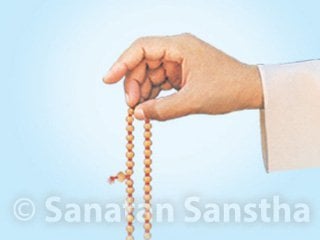 Why do we chant Name of Kuladevi instead of Kuladev?
Why do we chant Name of Kuladevi instead of Kuladev?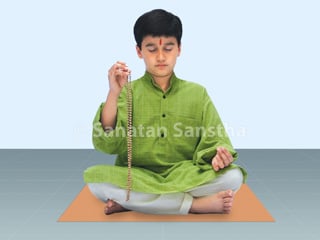 Guidance by His Holiness Bhagwantkumar Menrai on how to coordinate chanting the Name of God...
Guidance by His Holiness Bhagwantkumar Menrai on how to coordinate chanting the Name of God...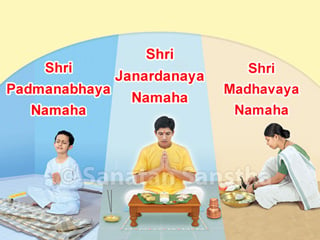 How different chants can help avoid unfavourable incidents ?
How different chants can help avoid unfavourable incidents ? How chanting purifies the mind ?
How chanting purifies the mind ?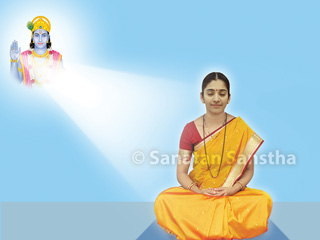 How does chanting help us to achieve oneness with God?
How does chanting help us to achieve oneness with God?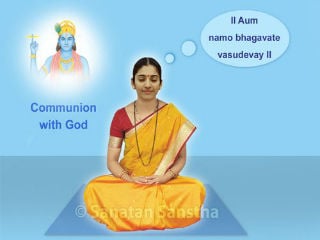 Spiritual benefits of chanting God’s Name
Spiritual benefits of chanting God’s Name